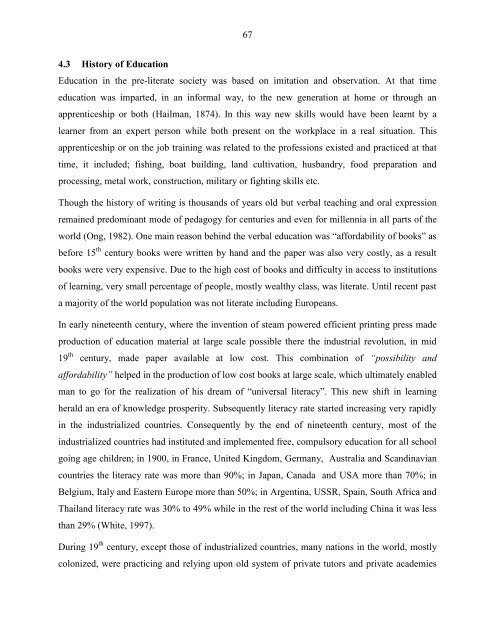Higher education in Asian countries and the role of international ...
Higher education in Asian countries and the role of international ...
Higher education in Asian countries and the role of international ...
You also want an ePaper? Increase the reach of your titles
YUMPU automatically turns print PDFs into web optimized ePapers that Google loves.
4.3 History <strong>of</strong> Education<br />
67<br />
Education <strong>in</strong> <strong>the</strong> pre-literate society was based on imitation <strong>and</strong> observation. At that time<br />
<strong>education</strong> was imparted, <strong>in</strong> an <strong>in</strong>formal way, to <strong>the</strong> new generation at home or through an<br />
apprenticeship or both (Hailman, 1874). In this way new skills would have been learnt by a<br />
learner from an expert person while both present on <strong>the</strong> workplace <strong>in</strong> a real situation. This<br />
apprenticeship or on <strong>the</strong> job tra<strong>in</strong><strong>in</strong>g was related to <strong>the</strong> pr<strong>of</strong>essions existed <strong>and</strong> practiced at that<br />
time, it <strong>in</strong>cluded; fish<strong>in</strong>g, boat build<strong>in</strong>g, l<strong>and</strong> cultivation, husb<strong>and</strong>ry, food preparation <strong>and</strong><br />
process<strong>in</strong>g, metal work, construction, military or fight<strong>in</strong>g skills etc.<br />
Though <strong>the</strong> history <strong>of</strong> writ<strong>in</strong>g is thous<strong>and</strong>s <strong>of</strong> years old but verbal teach<strong>in</strong>g <strong>and</strong> oral expression<br />
rema<strong>in</strong>ed predom<strong>in</strong>ant mode <strong>of</strong> pedagogy for centuries <strong>and</strong> even for millennia <strong>in</strong> all parts <strong>of</strong> <strong>the</strong><br />
world (Ong, 1982). One ma<strong>in</strong> reason beh<strong>in</strong>d <strong>the</strong> verbal <strong>education</strong> was “affordability <strong>of</strong> books” as<br />
before 15 th century books were written by h<strong>and</strong> <strong>and</strong> <strong>the</strong> paper was also very costly, as a result<br />
books were very expensive. Due to <strong>the</strong> high cost <strong>of</strong> books <strong>and</strong> difficulty <strong>in</strong> access to <strong>in</strong>stitutions<br />
<strong>of</strong> learn<strong>in</strong>g, very small percentage <strong>of</strong> people, mostly wealthy class, was literate. Until recent past<br />
a majority <strong>of</strong> <strong>the</strong> world population was not literate <strong>in</strong>clud<strong>in</strong>g Europeans.<br />
In early n<strong>in</strong>eteenth century, where <strong>the</strong> <strong>in</strong>vention <strong>of</strong> steam powered efficient pr<strong>in</strong>t<strong>in</strong>g press made<br />
production <strong>of</strong> <strong>education</strong> material at large scale possible <strong>the</strong>re <strong>the</strong> <strong>in</strong>dustrial revolution, <strong>in</strong> mid<br />
19 th century, made paper available at low cost. This comb<strong>in</strong>ation <strong>of</strong> “possibility <strong>and</strong><br />
affordability” helped <strong>in</strong> <strong>the</strong> production <strong>of</strong> low cost books at large scale, which ultimately enabled<br />
man to go for <strong>the</strong> realization <strong>of</strong> his dream <strong>of</strong> “universal literacy”. This new shift <strong>in</strong> learn<strong>in</strong>g<br />
herald an era <strong>of</strong> knowledge prosperity. Subsequently literacy rate started <strong>in</strong>creas<strong>in</strong>g very rapidly<br />
<strong>in</strong> <strong>the</strong> <strong>in</strong>dustrialized <strong>countries</strong>. Consequently by <strong>the</strong> end <strong>of</strong> n<strong>in</strong>eteenth century, most <strong>of</strong> <strong>the</strong><br />
<strong>in</strong>dustrialized <strong>countries</strong> had <strong>in</strong>stituted <strong>and</strong> implemented free, compulsory <strong>education</strong> for all school<br />
go<strong>in</strong>g age children; <strong>in</strong> 1900, <strong>in</strong> France, United K<strong>in</strong>gdom, Germany, Australia <strong>and</strong> Sc<strong>and</strong><strong>in</strong>avian<br />
<strong>countries</strong> <strong>the</strong> literacy rate was more than 90%; <strong>in</strong> Japan, Canada <strong>and</strong> USA more than 70%; <strong>in</strong><br />
Belgium, Italy <strong>and</strong> Eastern Europe more than 50%; <strong>in</strong> Argent<strong>in</strong>a, USSR, Spa<strong>in</strong>, South Africa <strong>and</strong><br />
Thail<strong>and</strong> literacy rate was 30% to 49% while <strong>in</strong> <strong>the</strong> rest <strong>of</strong> <strong>the</strong> world <strong>in</strong>clud<strong>in</strong>g Ch<strong>in</strong>a it was less<br />
than 29% (White, 1997).<br />
Dur<strong>in</strong>g 19 th century, except those <strong>of</strong> <strong>in</strong>dustrialized <strong>countries</strong>, many nations <strong>in</strong> <strong>the</strong> world, mostly<br />
colonized, were practic<strong>in</strong>g <strong>and</strong> rely<strong>in</strong>g upon old system <strong>of</strong> private tutors <strong>and</strong> private academies

















